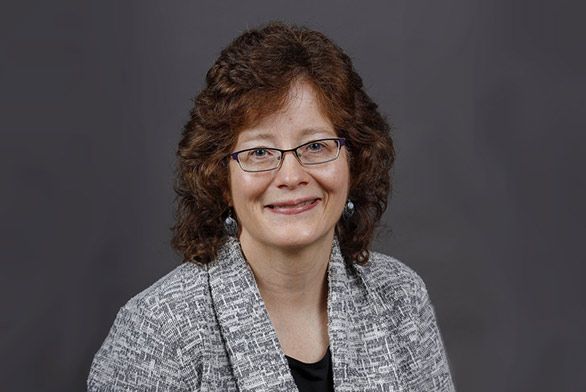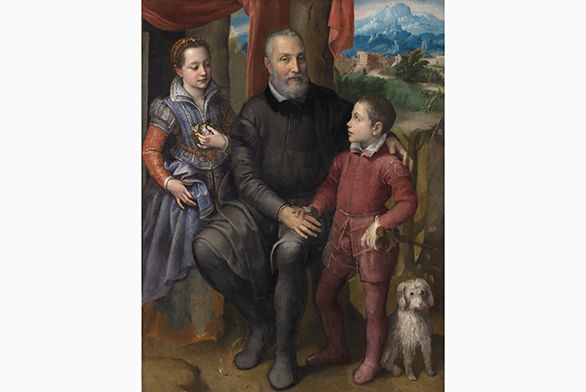Johnnie Alum Shines Light on the Women of Art History
February 26, 2021 | By Les Poling

Erika Gaffney (A89) can recall the precise chain of events that led her to create Art Herstory. In the fall of 2017, as she prepared for the upcoming birthday of a feminist art historian friend, “I thought, ‘I’ll get a card that has an image by an early modern woman artist, I’ll slap a birthday sticker in it, and I’ll be done,’” she recalls.
But it was nowhere near that simple. In fact, it was almost impossible. “I looked, looked, and looked and there was no such thing,” Gaffney says. “I could order Vermeer cards, I could order Van Gogh cards, but not Sofonisba Anguissola—not Artemisia Gentileschi. There weren’t any by Renaissance or Baroque women artists.”
She eventually found a personalized card on Zazzle, but the difficulty of the process rankled her. While she knew what to look for—as an acquisitions editor for Amsterdam University Press, she commissions books on early modern art—she recognized that most people likely wouldn’t have the same knowledge. Gaffney couldn’t stop thinking about all the important female figures of art history being relegated beneath the tier of popular consumption.
The unsettling experience stayed with her for months, she remembers; as time passed by, the frustration expanded into something more pressing—a sense of purpose. Finally, in March of 2018, she remembers telling her husband, “I think there’s something I have to do.”
And so Art Herstory was born: a combination note card business and art history website with a mission to recognize “notable women artists who were famous in their time, but whose names and works are not as well known today as those of some of their male contemporaries.” Complete with a shop, resource pages for early modern female artists represented in the Art Herstory collection, and a news/blog page—with entries by Gaffney and a wide array of contributors—the website is a multifaceted tool aiming to elevate an unjustly discarded group of golden-age artists.
For Gaffney, Art Herstory is both the product of irritated inspiration and part of a long journey in the humanities that dates back to her time at St. John’s. After graduating from the college, she began her career in scholarly publishing when she joined the marketing department at United Kingdom-based Ashgate Publishing. Following an organizational shift that saw her move from marketing humanities books to humanities and social sciences texts (“my job satisfaction dropped precipitously,” she says), she moved on to become Ashgate’s U.S.-based literary studies editor, initially working on medieval to 20th-century works before transitioning exclusively to medieval and early modern subjects.
During that time, she worked on an interdisciplinary series titled Women and Gender in the Early Modern World—a line that included visually stunning, low-cost art history books, and which led to Gaffney overseeing Ashgate’s U.S. art history department. After Ashgate was sold to a larger company in 2015, she decided to go freelance; a move that led to work as an editor for both Amsterdam University Press and Lund Humphries.
All of which is to say, Gaffney’s vast and wide-ranging editorial career has come in handy since she began Art Herstory—not in the least because the entire undertaking is a one-woman show. The only facet of creating her business that she didn’t do entirely on her own was website design and maintenance; the rest—including writing, soliciting, and editing blog entries, social media promotion, e-newsletter writing and sending, and packing and shipping A2 cards—is all Gaffney.

A family portrait by Sofonisba Anguissola; note card available on artherstory.net
The cornerstone of Art Herstory, from a business perspective, is the cards: reproductions of works by early modern female painters printed on high-quality card stock and sold on the Art Herstory website, as well as various museums. In the beginning, Gaffney says, she sold six different cards; these days, she offers 17 standard note cards, two Christmas-themed cards, one botanical holiday card, and a few non-card products. While she outsources the design and printing, she curates the actual selection, which includes painted self-portraits, traditional paintings of the Magi, and more.
To Gaffney’s surprise, though, the Art Herstory blog keeps her busiest—ironic, given that she initially included it for the sole purpose of driving traffic to the shop. In order to keep the blog active, she combines elements of her editorial experience with a certain amount of outreach within the broader art history community—and writes herself. She solicits blog entries from scholars, PhD students, undergrads, and more before editing their content, formatting their writing, and promoting blog posts across Art Herstory’s social media channels, where she posts at least once a day. Gaffney also tracks ongoing happenings around female artists in the art history world, looking for ways to leverage Art Herstory’s platform and forge a community among fellow art lovers.
“For example, I recently saw that the Met [Metropolitan Museum of Art] had acquired three paintings by a 17th-century Italian nun,” she says. But there was no press release, and a curator friend at the Met explained that mention of the bequest was merged into a general press release about museum news. “So I wrote a press release, I put it on the Art Herstory blog, and publicized it on social media.” (That press release eventually led to a story on Artnet.)
From writing and editing to commissioning to the monthly newsletter, Art Herstory necessitates an extraordinary amount of work—but, Gaffney says, it’s beginning to pay dividends. For one, the website has taken on a somewhat unexpected role as a valuable educational tool. She recalls a conversation with an art historian acquaintance who recently wrote a book on Sofonisba Anguissola, a 16th-century Italian artist. “I said, ‘I don’t know if you know about Art Herstory, but I’d love it if you’d write a blog post on Anguissola.’ And he said, ‘Oh, I know all about your website—my students told me!’”
More tangibly, Gaffney and Art Herstory recently won a 2020 Digital Scholarship, New Media, and Art Award from the Society for the Study of Early Modern Women and Gender (SSEMWG). The SSEMWG specifically cited the website’s appeal to members of both the academic community and the broader public—all of which “made me feel great,” Gaffney says.
She makes clear that Art Herstory is simply one part of a larger initiative to reclaim female Old Masters and restore to them their rightful cultural and historical significance. Such artists, Gaffney points out, were famous in their time, but have been inexplicably lost to history in the centuries since. Now, a growing number of people in the art history world are fighting to right that wrong. There are movies, like 2019’s Portrait of a Lady on Fire, that depict the commonplace nature of female artists. There are museums across the world, from the Uffizi in Florence to the National Gallery in London to DC’s National Gallery of Art (NGA), that are beginning to showcase early modern women; the NGA, Gaffney notes, has been a patron of Art Herstory from the beginning.
Overall, “there is a cultural movement right now that is focused on recovering the life stories, works, and contributions of women artists from history,” she explains. “It includes curators, art historians, dealers, collectors, even authors of historical fiction—and I’m leaving so many people out. This is not something I started.”
But cultural movements, like seminar tables, can only thrive with the participation of a cacophony of voices. And as momentum grows, Gaffney is proud that “Art Herstory participates in the movement to recover the contributions of women artists throughout history.”

